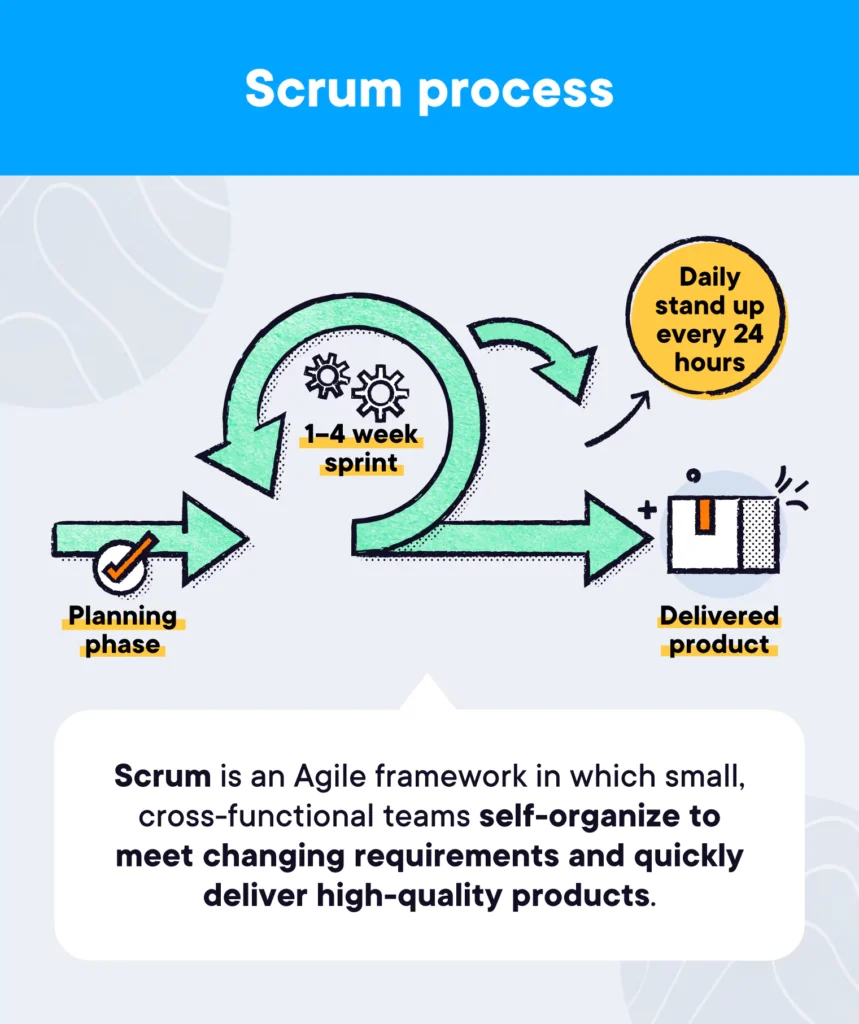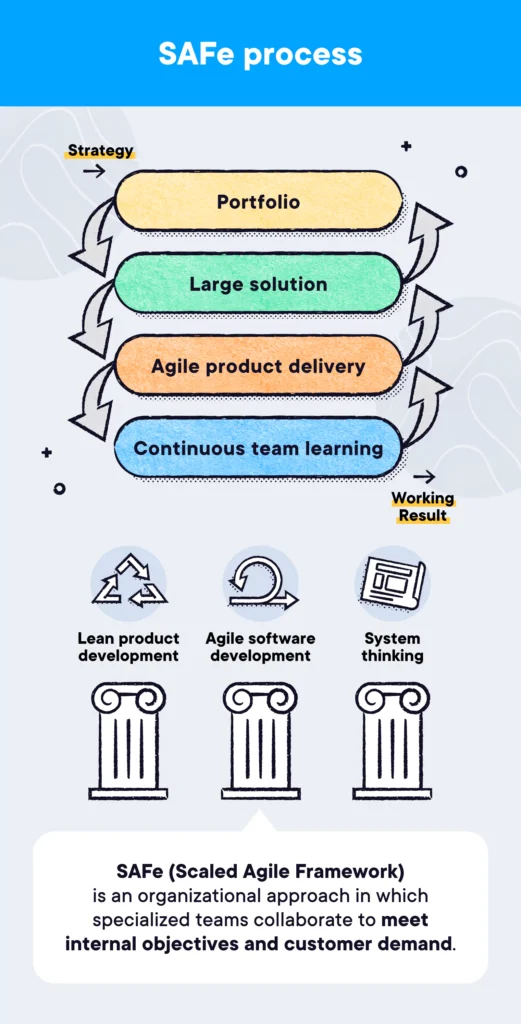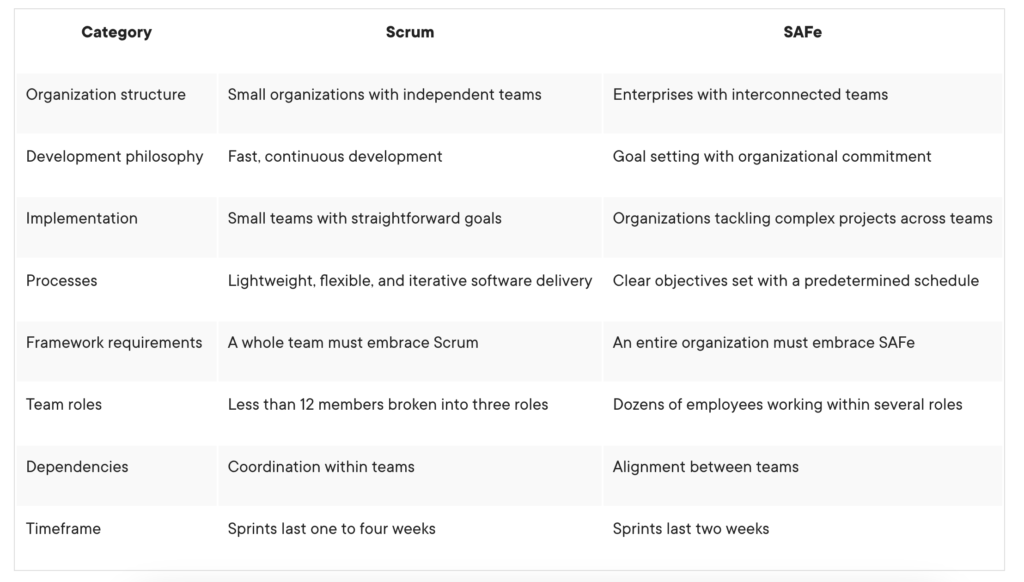Agile project management has gained significant momentum in software development, primarily because of its flexibility. One of the key benefits of Agile is the ability to choose a framework that best aligns with your organization’s unique needs and strengths. Among the most commonly adopted frameworks are Scrum and SAFe, and many companies find themselves deciding between the two.
While both frameworks are widely used, they can impact organizations in different ways. Choosing between Scrum and SAFe requires careful consideration of your team’s resources, objectives, and overall goals. In this article, we’ll explain the basics of both Scrum and SAFe, explore their similarities and differences, and help you determine which framework might be best suited for your team.
What is Scrum?

Scrum is an Agile framework that focuses on small, self-organized teams delivering high-quality software quickly. Its core principle is simplicity, which allows teams to stay adaptable and produce incremental deliveries based on continuous feedback from stakeholders. Scrum teams tackle large projects by breaking them down into smaller, manageable steps.
Scrum fosters cross-functional teams, empowering them to address a wide range of issues and project types. The small team structure not only boosts productivity and cost-effectiveness but also enhances communication, as every developer knows exactly who to turn to for specific issues. This streamlined setup encourages collaboration and thorough work reviews.
Key Roles in Scrum:
Product Owner: Aligns the team’s goals with customer and stakeholder expectations, offering feedback and guidance on product requirements.
Scrum Master: Facilitates the Scrum process, ensuring that the team stays on track by removing obstacles.
Scrum Team: Works together to meet goals outlined during the sprint planning phase, actively building and refining the product.
Pros and Cons of Scrum:
Pros:
Streamlined development process
Focus on customer needs and feedback
Quick delivery cycles
Easy coordination within small teams
Cons:
Harder to scale for larger projects
Requires extensive team training
Development cycles may not always align with deadlines
Who Should Use Scrum?
Scrum is best suited for smaller organizations and independent teams, especially when:
Frequent stakeholder feedback is required
Deliverables are constantly evolving
Quick turnaround times are needed for high-quality products
What is SAFe?

The Scaled Agile Framework (SAFe) is designed to help larger organizations set objectives and meet customer demands at scale. While Scrum emphasizes small, autonomous teams, SAFe coordinates multiple teams and leaders to tackle projects too large or complex for Scrum to handle alone.
SAFe brings more structure and oversight, which is beneficial for larger enterprises. It leverages three core principles:
Lean Product Development: Focuses on reducing waste and optimizing processes, ensuring efficiency and continuous development.
Agile Software Development: Encourages iterative, incremental changes based on feedback, while remaining flexible for quick adaptations.
Systems Thinking: Ensures that solutions are designed with a holistic view of how all parts of the system interact and integrate.
Pros and Cons of SAFe:
Pros:
Enables enterprise-level agility and competitiveness
Enhances cooperation across multiple teams
Adds safeguards to prevent issues in production
Cons:
Not ideal for small organizations or startups
Requires a shared Agile framework and language
Operates under a more rigid, top-down structure
Who Should Use SAFe?
SAFe is most effective for larger organizations that:
Have multiple interconnected teams
Operate under a top-down leadership model
Handle complex, cross-team projects
Key Differences Between Scrum and SAFe
While both frameworks aim to improve Agile processes, there are key differences between Scrum and SAFe that can influence which is the right fit for your organization:

Similarities Between Scrum and SAFe

Despite their differences, Scrum and SAFe share common ground:
Team-Centric Development: Both rely heavily on teams rather than individual contributors.
Incremental Delivery: Both frameworks focus on delivering value in smaller, incremental steps.
Stakeholder Involvement: Collaboration with stakeholders is key to ensure that feedback is continuously incorporated.
Regular Inspections: Both frameworks promote frequent reviews and adaptations.
Timeboxing: Scrum and SAFe utilize timeboxing to manage tasks and ensure deadlines are met.
Continuous Delivery: Both frameworks aim for regular software updates using continuous delivery pipelines.
Scrum@Scale: A Hybrid Approach
For organizations that want the flexibility of Scrum but need to scale for larger teams, Scrum@Scale offers a middle ground. This framework extends Scrum’s benefits across multiple teams, creating a collaborative network that focuses on shared goals. Scrum@Scale introduces new roles, such as the Chief Product Owner (CPO) and Scrum of Scrums Master (SoSM), to ensure smooth operations across teams.
Conclusion: Choosing Between Scrum and SAFe
When deciding between Scrum and SAFe, consider your organization’s size, structure, and objectives. Scrum is the best fit for smaller, independent teams that need agility and fast delivery. SAFe, on the other hand, is more appropriate for large organizations that require coordination and structure across multiple teams. Both frameworks offer value, but the right choice will depend on your specific needs and goals.
